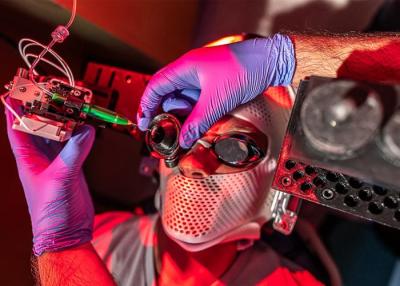
Research on new head-mounted robotics device offers a glimpse into the future of eye surgery. Image credit: Moran Eye Center, University of Utah
When even the most highly trained surgeons perform procedures on the retina—one of the smallest, most delicate parts of the human body—the stakes are high. Surgeons must account for patients’ breathing, snoring, and eye movements, along with their own involuntary hand tremors, while they work on a layer of cells less than a millimeter thick.
That’s why researchers at the University of Utah’s John A. Moran Eye Center and the John and Marcia Price College of Engineering have collaborated to create a new robotic surgery device that aims to give surgeons “superhuman” hands.
The robot itself is extremely precise, executing movements as small as 1 micrometer (smaller than a single human cell). It is mounted directly to the patient’s head using a helmet, such that subtle (and sometimes not so subtle) movements of the patient’s head are compensated for, keeping the eye quite still from the perspective of the robot. The robot also scales down the surgeon’s movements, measured using a handheld robotic device known as a haptic interface, to the much smaller surgical site within the eye, compensating for hand tremors along the way.
In the experiments described in the study, the surgeons achieved higher success rates while using the surgical robot device to perform subretinal injections while also avoiding ophthalmic complications.
While still in the testing stages, the device aims to improve outcomes for patients and support cutting-edge procedures, including the delivery of gene therapies for inherited retinal diseases.